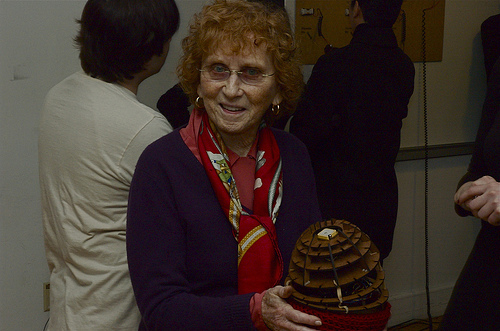This post is Re-posted from Corey’s Blog. Corey and I took the same Class taught by Red called “Applications of Interactive Technologies.” Red’s first class is the beginning to an eye opening experience called the Interactive Telecommunications Program at NYU. You can begin to gage the intensity of this program through this simple list. I am really, really, grateful to have met & interacted with Red Burns and to have gotten to know such a talented group of people, the “… misfit toys” as Clay Shirky would call us. NYU’s ITP is the seed that Red Burns planted. Only time will see ITP’s flowers bloom and time’s offspring to feed from it’s fruits. ~Oscar
——————— Re-Blog Start ————————-
“!blog”
“not a blog by Corey Menscher”
What Red Wanted
Since Red Burns’s recent passing, I went back over my notes from the first day of her Applications class at ITP. I didn’t expect to find much, but it turns out I had transcribed what she had up on the projector during her intro to the course. It was the true kickoff to our ITP experience. Here it is…
“What I want you to know…”
- THAT YOU ARE DRIVEN BY CURIOSITY
- That there is a difference between the mundane and the inspired
- The biggest danger is not ignorance, but the illusion of knowledge
- That any human organization must inevitably juggle internal contradictions – the imperatives of efficiency and the countervailing human trade-offs
- That the inherent preferences in orgs are efficiency, clarity, certainty, and perfection. (Which humans are not.)
- Human beings are ambiguous, uncertain, and imperfect
- How you balance and integrate these contradictory characteristics is difficult
- That imagination, not calculation, is the “difference” that makes the difference
- That you are a new kind of professional – comfortable with analytical and creative modes of learning
- That there is knowledge shift from static kownledge toa dynamic search paradigm
- That creativity is not the game preserve of artists, but an intrinsic feature of all human activity
- That in any creative endeavor you will be discomfited and that is part of learning
- That there is a difference b/w long term success and short term flash
- That there is a complex connection between social and technological trends. It is virtually impossible to unravel except by hindsight.
- You ask yourself what you want and then you work backwards
- In order to problem solve and observe you ought to know how to: analyze, probe, question, hypothesize, synthesize, select, measure, communicate…
“What I hope for you…”
- That you combine that edgy mixture of self-confidence and doubt.
- Enough self-confidence to try new things
- Enough self doubt to question
- That you think of technology as a verb – not a noun (It is a subtle but
- important difference)
- That you remember the issues are usually not technical
- That you create opportunities to improvise
- That you communicate emotion
- That you observe, imagine, and create
- That you look for the question not the solution
- That you don’t see the world as a market…a place to live in and are designing for people
- That you have a stake in magic and mystery
- That poetry drives you, not hardware (art has a place in all of this)
- That you develop a practice founded in critical reflection
- That you are willing to risk, make mistakes, and learn from failure
- That you build a bridge between theory and practice
- That you embrace the unexpected
- That you value serendipity
Then she left us with a poem.
Come to the edge
It’s too high
Come to the edge
We might fall
Come to the edge
And he pushed them and they flew
(by Guillaume Apollinaire)
Red’s way of getting us to be our best was to throw us off the cliff. That’s so her. Thanks for the push, Red.
